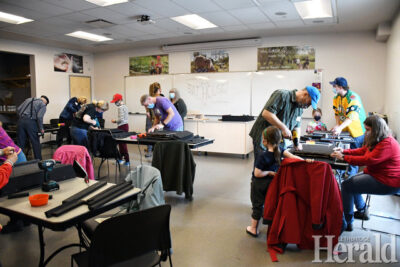Bat house workshop aims to help conserve local flying mammals
By Alejandra Pulido-Guzman - LETHBRIDGE HERALD on October 26, 2021.
 Herald photo by Alejandra Pulido-Guzman
Members of the community gathered to build bat houses and learn about the different species of bats that live in Alberta during an event Saturday at the Helen Schuler Nature Centre.
Herald photo by Alejandra Pulido-Guzman
Members of the community gathered to build bat houses and learn about the different species of bats that live in Alberta during an event Saturday at the Helen Schuler Nature Centre.The Helen Schuler Nature Centre hosted experts from the Alberta Community Bats Program on Saturday to help members of the community build bat houses while learning about the different bat species that live in Alberta.
“We have nine different species in Alberta, three of them are migratory species and the others all stay and hibernate over the winter,” explained Susan Holroyd, Calgary region Coordinator for the Alberta Community Bat Program.
During the Bat House Building Workshop, they hosted a presentation about how to help conserve bat populations and how to build bat houses that would provide a proper habitat for the bats.
Community members built bat houses mainly for two species that live in Alberta called ‘Big Brown Bats’ and ‘Little Brown Myotis’, with the latter listed federally as an endangered species, because in 2006 a fungus was introduced to North America that is believed to have originated in Europe, called White Nose Syndrome.
“A disease that they get from the fungus, which is a cold-loving fungus, that likes to live in caves where bats like to hibernate, it likes cold temperature and high relative humidity which is the critical habitat for bats when they are hibernating and this fungus can grow in any organic material,” said Holroyd.
The idea behind this event was for people to take them home, and place them around their homes, by either mounting them onto their house or their garage or some sort of structure to attract bats into our cities and into our neighbourhoods.
“Those are bat houses that meet the design standards, so that bat species that live here will actually use them and will actually roost in them for their maternity roosts, so mother bats will give birth to their bat young,” said Anna Larney, Facility Programing Coordinator for Helen Schuler Nature Centre.
Larney added that sometimes people have bats that roost in buildings, with bat houses being a good way to provide habitat that isn’t necessarily inside of your garage or inside of your shed, but still providing the necessary habitat for bats in a way that also suits property owners as well.
The Alberta Community Bat Program was put in place initially in 2016 for the citizen science project, to get Albertans to submit data on bat roosts that they have.
“When they have a bat house in their backyard like everybody is building today and they have a colony of bats, we ask them to spend an hour, half an hour after sunset in the summer time, and watch their bat house and count how many bats come out and then write it down and report it to us,” said Holroyd.
They do that early in the season and later in the season, so that it can give the ACBP an idea of how many babies they produced.
“If we have data for a number of years for a large number of samples, we can come back with an index of the population,” added Holroyd.
The information supplements data that Alberta Environment will use to manage bats in the province, since the department did not have anyone counting bats before.
For more information visit http://www.albertabats.ca
Follow @APulidoHerald on Twitter
3-2




